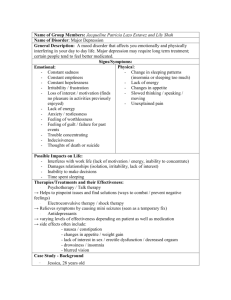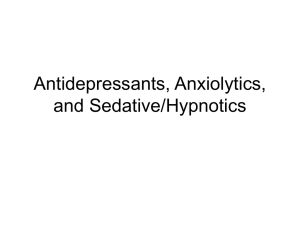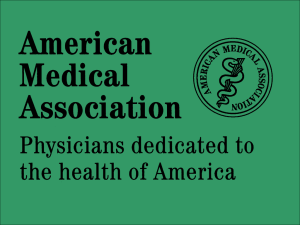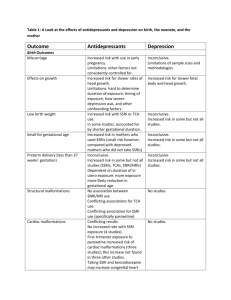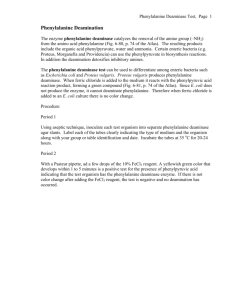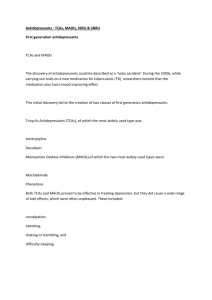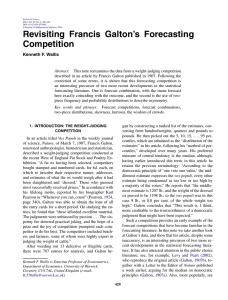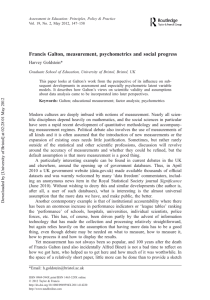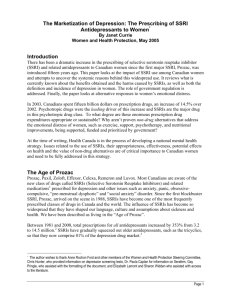AP psychology terms not in Myers 8th Edition
advertisement
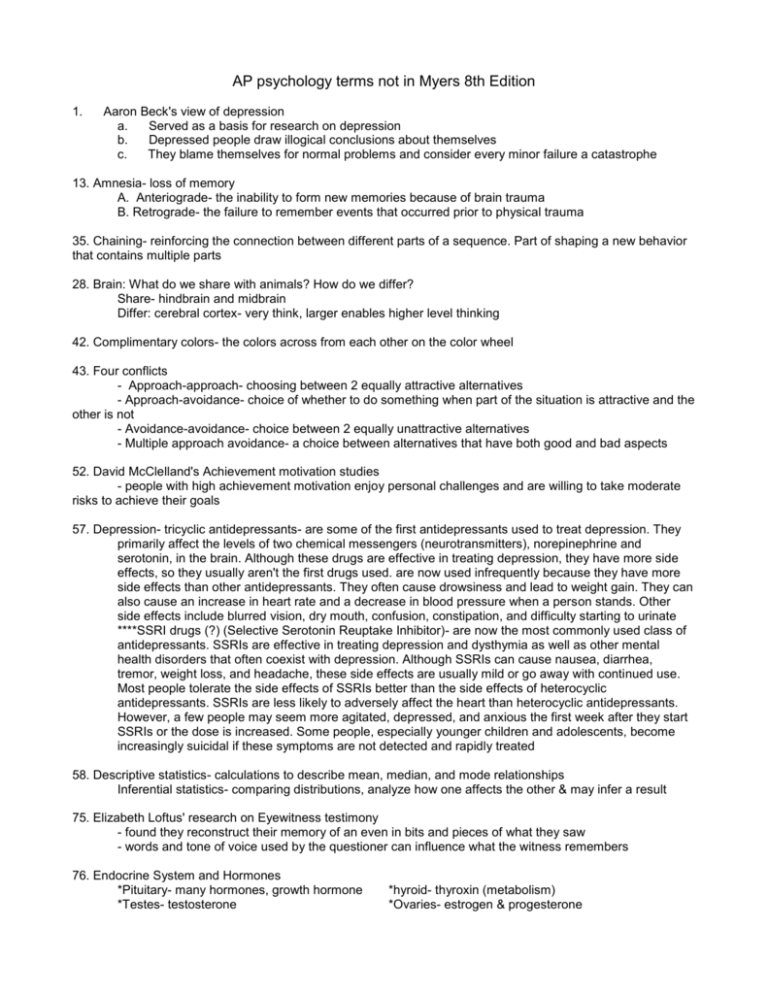
AP psychology terms not in Myers 8th Edition 1. Aaron Beck's view of depression a. Served as a basis for research on depression b. Depressed people draw illogical conclusions about themselves c. They blame themselves for normal problems and consider every minor failure a catastrophe 13. Amnesia- loss of memory A. Anteriograde- the inability to form new memories because of brain trauma B. Retrograde- the failure to remember events that occurred prior to physical trauma 35. Chaining- reinforcing the connection between different parts of a sequence. Part of shaping a new behavior that contains multiple parts 28. Brain: What do we share with animals? How do we differ? Share- hindbrain and midbrain Differ: cerebral cortex- very think, larger enables higher level thinking 42. Complimentary colors- the colors across from each other on the color wheel 43. Four conflicts - Approach-approach- choosing between 2 equally attractive alternatives - Approach-avoidance- choice of whether to do something when part of the situation is attractive and the other is not - Avoidance-avoidance- choice between 2 equally unattractive alternatives - Multiple approach avoidance- a choice between alternatives that have both good and bad aspects 52. David McClelland's Achievement motivation studies - people with high achievement motivation enjoy personal challenges and are willing to take moderate risks to achieve their goals 57. Depression- tricyclic antidepressants- are some of the first antidepressants used to treat depression. They primarily affect the levels of two chemical messengers (neurotransmitters), norepinephrine and serotonin, in the brain. Although these drugs are effective in treating depression, they have more side effects, so they usually aren't the first drugs used. are now used infrequently because they have more side effects than other antidepressants. They often cause drowsiness and lead to weight gain. They can also cause an increase in heart rate and a decrease in blood pressure when a person stands. Other side effects include blurred vision, dry mouth, confusion, constipation, and difficulty starting to urinate ****SSRI drugs (?) (Selective Serotonin Reuptake Inhibitor)- are now the most commonly used class of antidepressants. SSRIs are effective in treating depression and dysthymia as well as other mental health disorders that often coexist with depression. Although SSRIs can cause nausea, diarrhea, tremor, weight loss, and headache, these side effects are usually mild or go away with continued use. Most people tolerate the side effects of SSRIs better than the side effects of heterocyclic antidepressants. SSRIs are less likely to adversely affect the heart than heterocyclic antidepressants. However, a few people may seem more agitated, depressed, and anxious the first week after they start SSRIs or the dose is increased. Some people, especially younger children and adolescents, become increasingly suicidal if these symptoms are not detected and rapidly treated 58. Descriptive statistics- calculations to describe mean, median, and mode relationships Inferential statistics- comparing distributions, analyze how one affects the other & may infer a result 75. Elizabeth Loftus' research on Eyewitness testimony - found they reconstruct their memory of an even in bits and pieces of what they saw - words and tone of voice used by the questioner can influence what the witness remembers 76. Endocrine System and Hormones *Pituitary- many hormones, growth hormone *Testes- testosterone *hyroid- thyroxin (metabolism) *Ovaries- estrogen & progesterone 78. Engram- A physical alteration thought to occur in living neural tissue in response to stimuli, posited as an explanation for memory 79. Episodic memory= flashbulb memory 82. Ethics of testing 1. promote the dignity of an individual 2. Foster human welfare 3. maintain scientific integrity 4. Prevent research and treatments that will be harmful to human participants 85. Hubel and Wisel- visual processing- feature detectors- why did they win the nobel prize? 93. Francis Galton's research Galton was one of the first experimental psychologists, and the founder of the field of enquiry now called Differential Psychology, which concerns itself with psychological differences between people, rather than on common traits. He started virtually from scratch, and had to invent the major tools he required, right down to the statistical methods - correlation and regression - which he later developed. These are now the nuts-and-bolts of the empirical human sciences, but were unknown in his time. One of the principal obstacles he had to overcome was the treatment of differences on measures as measurement error, rather than as natural variability. His influential study Hereditary Genius (1869) was the first systematic attempt to investigate the effect of heredity on intellectual abilities, and was notable for its use of the bell-shaped Normal Distribution, then called the "Law of Errors", to describe differences in intellectual ability, and its use of pedigree analysis to determine hereditary effects. Later Galton went on to suggest the use of twin studies to disentangle nature from nurture, by comparing identical twins to fraternal twins. The research program that Galton initiated in this regard has developed into the important field of behaviour genetics. Galton later broadened his study of human traits into general anthropometry, or "measurement of man", trying to find as many measurable traits as possible, so that their distribution and heritability could be determined. His psychological studies also embraced mental differences in visualization, and he was the first to identify and study "number forms", now called "synaesthesia". He also invented the word-association test, and investigated the operations of the sub-conscious mind. His work in this area was collected into a wideranging volume called Inquiries into Human Faculty, which must be read today with Galton's broader research program in mind: to identify and measure variable human traits. 95. Frequency Polygon- constructed form of a frequency table. Used when recording IQ scores. Intervals are shown on the X axis and # of scores in each interval is represented by the height of a point located above the middle of the interval 101. Galvanic Skin response- a measure that monitors physical arousal . Physiology, the GSR reflects sweat gland activity and changes in the sympathetic nervous system and measurement variables. Measured from the palm or fingertips, there are changes in the relative conductance of a small electrical current between the electrodes. The activity of the sweat glands in response to sympathetic nervous stimulation ( Increased sympathetic activation ) results in an increase in the level of conductance. There ia a relationship between sympathetic activity and emotional arousal, although one cannot identify the specific emotion being elicited. Fear, anger, startle response, orienting response and sexual feelings are all among the emotions which may produce similar GSR responses. 102. Ganglia- bundles of nerves - affect personality and reaction time - located anywhere in the body 103. Gansfeld procedure- used in ESP studies, involving telepathy, one person acts as a "sender" and the other a "receiver." The sender looks at randomly selected images, such as photographs, and tries to "transmit" an image to the receiver in another room. The receiver is then shown 4 images and asked to select the one that was transmitter by the sender. Guessing nets ? by change. This procedure had higher results. 118. High vs. Low self monitors- tendency for an individual to observe the situation for cues about how to react 120. Histogram-a way of graphically representing a frequency distribution, a type of bar chart using vertical bars that touch 128. IDEAL- Problem Solving I= identify D= define E= explore A= act on best strategy L= Look back and revise 136. induced motion- the perception of motion in the absences of movement across the retina caused by movement of its background or surrounding context. 137. Inductive reasoning- form of thinking that involves using individual cases or particular facts to reach a general conclusion Deductive reasoning- form of thinking in which conclusions are inferred from premises; the conclusions are true if the premises are true (if this, then that) 149. John Garcias' ideas on the limits of conditioning- taste aversion could occur in one trial, and the effects could be lasting - showed that ALL stimuli do NOT have the potential for becoming conditioned stimuli (biological predispositions) 151. Karen Horney's view on development- agreed with Freud that childhood experiences play a major role in the development of adult personality - she believed the greatest influence on personality are social interactions - parent-child relationship is most important (good & bad) but that genuine and consistent love could temper the effects of the most painful childhoods 154. Kubler-Ross stages of dying/grief 1. denial 2. anger 3. bargaining 4. depression 5. acceptance 159. Linkage analysis- used to find where genes are on the chromosome(s) 161. Localization of sound- the placement of our 2 ears allows us to enjoy stereophonic (3-D) hearing - hearing a sound first in one ear or more loudly in one ear helps us to tell where it is coming from 166. Martin Seligman's learned helplessness- taught dogs that they were helpless to escape from electric shock. Placed barrier in cage to prevent dogs from leaving when being shocked. Removed the barrier, but dogs made no effort to escape. This "learned helplessness" behavior has been compared/seen in people who are depressed. They feel past/future events are out of their control and they are helpless= depression 179. Motion aftereffect- a type of motion illusion, when the subject is focused on an object moving in one direction, when the object stops, perception of motion in the opposite direction occurs. is a visual illusion experienced after viewing a moving visual stimulus for a time (milliseconds to minutes) with stationary eyes, and then fixating a stationary stimulus. The stationary stimulus appears to move in the opposite direction to the original (physically moving) stimulus. Like all aftereffects, this one is due to the fact that the nerve cells that signal motion in the direction the stimulus is moving in fatigue after several seconds or more of continuous firing activity. 180. Motion Parallax- the tendency of objects to move forward or backward depending on how far away the are from the viewer, Motion parallax is a depth cue that results from our motion. As we move, objects that are closer to us move farther across our field of view than do objects that are in the distance. http://psych.hanover.edu/krantz/MotionParallax/MotionParallax.html 187. Newborn baby reflexes1. rooting 2. sucking 3. grasping 4. swallowing 5. startle (moro) 6. babinsky 202. Pancreas- large glad that secretes digestive enzymes and the hormone insulin 208. Personal Space- the buffer zone we like to maintain around our bodies 210. Phenylketonuria- a metabolic disorder that, untreated, results in mental retardation and other problems. Phenylketonuria (PKU) is a genetic disorder that is characterized by an inability of the body to utilize the essential amino acid, phenylalanine. Amino acids are the building blocks for body proteins. 'Essential' amino acids can only be obtained from the food we eat as our body does not normally produce them. In 'classic PKU', the enzyme that breaks down phenylalanine phenylalanine hydroxylase, is completely or nearly completely deficient. This enzyme normally converts phenylalanine to another amino acid, tyrosine. Without this enzyme, phenylalanine and its' breakdown chemicals from other enzyme routes, accumulate in the blood and body tissues. Chronically high levels of phenylalanine and some of its breakdown products can cause significant brain problems. The following describes untreated PKU symptoms-currently a rarity: About 50% of untreated infants have early symptoms, such as vomiting, irritability, an eczema-like rash, and a mousy odor to the urine. Some may also have subtle signs of nervous system function problems, such as increased muscle tone, and more active muscle tendon reflexes. Later, severe brain problems occur, such as mental retardation and seizures. Other commonly noted features in untreated children include: microcephaly (small head), prominent cheek and upper jaw bones with widely spaced teeth, poor development of tooth enamel, and decreased body growth. 221. Premack Principle- operant conditioning- more preferred activities reinforce less preferred ones - the more preferred activities obviously depend on the individual 231. Reflex arc- how neurons differ from others? 237. Robert Rescorla's finding on conditioning- when two significant events occur close together in time, and animal learns the predictability of the second event 257. Sleeper Effect- the delayed impact on attitude change of a persuasive conversation. People may come to reach a different conclusion about a message after a period of time has elapsed. 273. Tay-sach's disease- deterioration of the brain of a one-year old child due to accumulation of fat on the brain (The condition is caused by insufficient activity of an enzyme called beta-hexosaminidase A that catalyzes the biodegradation of acidic fatty materials known as gangliosides. Gangliosides are made and biodegraded rapidly in early life as the brain develops.). The child will usually die before age 4. Infants with Tay-Sachs disease appear to develop normally for the first few months of life. Then, as nerve cells become distended with fatty material, a relentless deterioration of mental and physical abilities occurs. The child becomes blind, deaf, and unable to swallow. Muscles begin to atrophy and paralysis sets in. Other neurological symptoms include dementia, seizures, and an increased startle reflex to noise. 279. Tourette's syndrome- neurological disorder which becomes evident in early childhood or adolescence before the age of 18 years. Tourette syndrome is defined by multiple motor and vocal tics lasting for more than one year. The first symptoms usually are involuntary movements (tics) of the face, arms, limbs or trunk. These tics are frequent, repetitive and rapid. The most common first symptom is a facial tic (eye blink, nose twitch, grimace), and is replaced or added to by other tics of the neck, trunk, and limbs. No definite cause has yet been established, but considerable *****evidence points to abnormal metabolism of at least one brain chemical called dopamine. 280. Tradegy of the commons- doctrine which insists we will always opt for an immediate benefit at the expense of less tangible values as the availability of a resource to future generations. (human nature) 284. Monosomy X- 1/5000 births- is only known viable human monosomy. The XO individuals are phenotypically female; their sex organs do not mature at adolescence, and secondary sex characteristics fail to develop. The individuals are sterile and short. They usually have no mental deficiency. 288. Water balance- role of the hypothalamus- controlled by this gland, the hypothalamus controls specific maintenance duties for the body, including hunger, thirst, body temperature and sexual behavior. 295. Androgyny- Having both female and male characteristics; hermaphroditic. Being neither distinguishably masculine nor feminine, as in dress, appearance, or behavior. 296. Catharsis- A technique used to relieve tension and anxiety by bringing repressed feelings and fears to consciousness. 297. Haptic Memory-sensory memory for touch 298. Syllogism- a deductive scheme of a formal argument consisting of a major and a minor premise and a conclusion (as in "every virtue is laudable; kindness is a virtue; therefore kindness is laudable") (deductive reasoning) 299. Central route to persuasion- refers to the case whereby people elaborate on a persuasive communication, listening carefully to and thinking about the arguments; this occurs when people have both the ability and the motivation to listen carefully to a communication 300. Optimistic explanatory style- Explanatory style is the way in which we explain the events that happen to us in our lives, either good or bad. Some of us may have a more pessimistic explanatory style, so that we blame ourselves when things don't go right (eg "it was my fault") and will not take credit for successes, (eg "it was just luck"). Some of us may have a more optimistic explanatory style so that we do not blame ourselves 100% for things that go wrong and we realise there are other external influences on what happens



